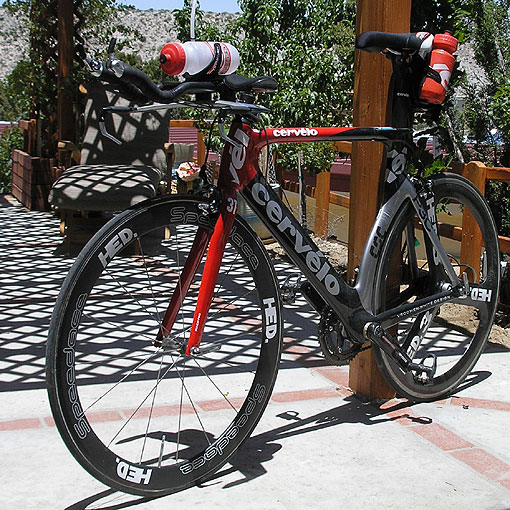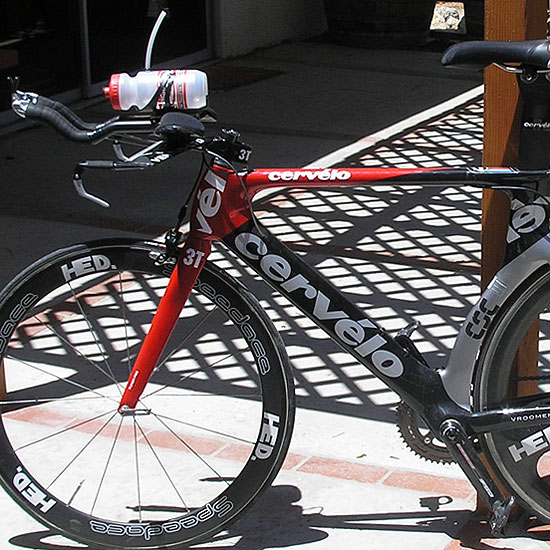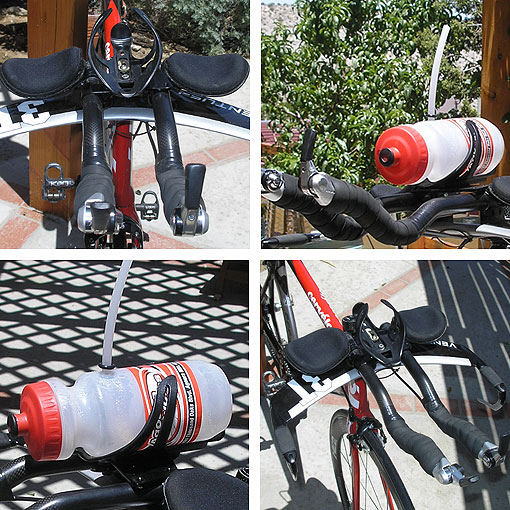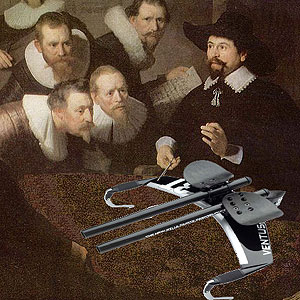Preferred Build: Cervelo P3C

When I change the parts on a bike, it is almost never because a brand "belongs" on it. Yes, you think of Campagnolo parts hanging on Pinarello Prince, but tri bikes aren't bluebloods. Some road race bikes are bluebloods. Tri bikes are mixed breeds. Tri bikes are Creole and Pidgin.
When I change the parts on a bike, it's because one part is a better functional fit, maybe a better thematic fit, maybe a better cosmetic fit, but never because it's a better brand fit. Indeed, would you put a Campy Record gruppo and a plug-in brake lever on a Pinarello Montello FM1? Actually, yes, if you're Pinarello. That's the featured build on the FM1 on its website. But, there is no plug-in brake lever I know of that spreads the calipers at the lever. Campy brake calipers have no spreading mechanism, that's all done at the Ergopower brake lever. So, how do you spread the calipers if you need to get anything fatter than a 20mm tire through those calipers? See, function does trump branding.
The P3C comes standard with a "Dura Ace TT/Tri" kit, which is to say, the least amount of Dura Ace Cervelo can get away with (derailleurs and shifters). As for the rest of the gruppo, I didn't change any of it, because the non-Dura Ace that's on that bike works fine. Yes, that even means the "Cervelo" brake calipers and, no, they were never prizes in Cracker Jack boxes — that's a vicious lie. Those calipers are not sexy, but they stop the bike adequately. The FSA SLK Light MegaExo crank likewise works fine. As do the wheels, the tires, and the minor parts. No reason to change for the sake of change.

Here's the thing about the P3C, though: it's built on the premise of its aerodynamics, that is, the functional "upgrade" of the P3C over the P3SL, or P2SL, was not geometric. It was chiefly aerodynamic. So, if aero is what floats your boat, why not place a truly wind cheating bar on a truly wind cheating frameset?
It's not that the stock Visiontech clip-on is unworthy. Bang for buck, it's hard to beat that bar. But, cost no object, I thought the 3T Ventus (the aerobar CSC rides) was the way to go. Plus, the Ventus matched my fit coordinates nicely. In fact, I actually chose the Ventus first, and got myself a P3C because the Ventus is notoriously unadjustable in terms of stem length and pitch. But once I got the bike altogether, and rode it, I was glad I went to the trouble. Built this way, this is a true superbike.
Nice aerobars, but it wasn't as simple as just slapping them on. The Ventus works wonderfully, but the screws kept coming loose. So, I had to blue Loctite them all. 3T could take a page from Profile, which Loctites all its bolts and screws prior to shipment.
And those straight extensions had to go. I replaced them with Blackwell's Wrist Relief extensions, which are the way to ride these bars best. Almost every aerobar on the market would benefit from having an extension shape like the Blackwell's.
Once I got it all set up, my fit coordinates went like this:
Sadddle height: 78.5cm
Saddle nose to BB: 1cm in front
Saddle nose to bar tip: 79cm
Saddle nose to armrest back: 46.5cm
Saddle to armrest elevation: -16cm
Seat angle thru saddle rail midpoint: 79.0°
But I wasn't done with it.
The saddle had to go. Nobody, not even Cervelo, makes an acceptable OE saddle. In fact, these days it occurs to me that bikes ought not to even come with saddles. Like pedals, they ought to come without, and let the retailer match you to your aftermarket saddle. I wonder what is the cost, worldwide, in fossil fuels due to the manufacture of OE bicycle saddles that never see the road. If all the OE saddles taken off all the bikes in all the stores were thrown in one pile, how high would it be?
Anyway, I put a Profile Design TriStryke on the thing.

About the P3C, and its aerodynamics, I just found it hard to keep looking at that cage on the downtube. So I took it off. I used another Blackwell product — an aerobar armrest clamp — and bolted it onto the aerobar extension. It was just about perfect for mounting a water bottle cage in between the armrests. I drilled a hole in the bottle, pushed in a run of stiff plastic tubing I got at the hardware store, a couple of O-rings, and presto, drink system.
Why didn't I just put an aftermarket drink system on the bike? Because I'll generally just take this bottle out of the cage and replace it with a regular bottle for my training rides. A bottle here, along with bottles attached to the Hydrotail behind the seat, is just fine for training.
It should be noted that I'm not racing anything longer than an Oly distance this season, so I don't need to refill my bottle during a race. That's why this system works for me. Were I to need to refill my handlebar mounted bottle on the fly, I'd certainly use an aftermarket drink system built for the purpose.
One final thought on how this bike rides. The P3C comes with the 3T fork, built with 43mm of offset paired with a 72.5 degree head angle. This gives the bike just over 60mm of trail, which is perfect to keep it rolling straight and steady, without having to fight with the darn thing. It's built with just over 64cm of front/center, so my weight on my 6'2" frame is displaced nicely front-to-rear, and those Ventus aerobars feature a pursuit position that sets the hands back a bit toward the steering axis. This means the steering "lever" — the distance from the steering axis to the contact point where the rider executes a turn — is not overlong. This may sound like a lot of technical gobbledigook, but it's a way of telling you that it handles and rides like a dream. And if it didn't, I wouldn't be keeping it a secret from you.



